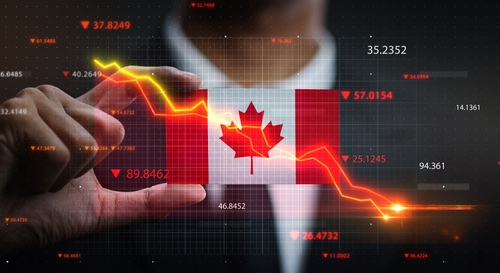

This article is only available to Macro Hive subscribers. Sign-up to receive world-class macro analysis with a daily curated newsletter, podcast, original content from award-winning researchers, cross market strategy, equity insights, trade ideas, crypto flow frameworks, academic paper summaries, explanation and analysis of market-moving events, community investor chat room, and more.
Summary
- The BoC cut 25bp as expected, while ending QT.
- The reduction in 2025 GDP growth forecast is not dovish as the BoC reduced its assumption for potential growth.
- Importantly, the bank’s estimate of the output gap narrowed to -0.75% from -1.25%. This implies there is less economic slack than previously thought.
- Despite stronger consumer spending and housing data, the Bank signalled it would cut rates if tariffs were imposed.
- CAD’s 6% decline since October is raising concerns, with about 4% of this attributed to market fears about potential tariffs.
Market Implications
- We remain long CAD as part of our short USD basket trade.
- The belly and long-end Canadian rates should underperform in the event of no tariffs.
BoC Cuts 25bp, Reduces Assumption of Economic Slack, Ends QT
The BoC cut the policy rate 25bp and the deposit rate 30bp yesterday. They also ended QT and updated their forecasts and assumptions:
Q4 Forecasts
- Q4 CPI forecast was lowered to 1.9% from 2.1% in line with our expectations.
- Q4 core CPI forecast rose to 2.6% from 2.3% in line with our expectations.
- Q4 GDP growth forecast fell to 1.8% from 2.0%, partly due to a slight upward revision to Q3. We see room for an upside surprise on stronger consumer spending.
Looking Ahead
- The BoC now believes potential GDP growth has fallen to 1.5% from 2.4% in 2024 due to lower immigration.
- Since the last quarter, the bank’s estimate of the output gap has narrowed to -0.75% from -1.25%. This implies less economic slack exists than previously thought.
- Population growth is expected to shrink 0.5% in 2025 versus growth of 1.7% previously.
- 2025 GDP growth was revised down to 1.8% due to the downward revision to potential growth. Therefore, this is not a dovish change.
- 2025 core CPI forecast remained the same at 2.1%.
- 2025 headline CPI forecast rose to 2.4% from 2% previously due to a weaker CAD and higher oil prices.
Importantly, the BoC highlights that while their forecast does not assume the imposition of new tariffs, they do assume lower investment due to increased trade uncertainty.
Economy Recovery, Tariffs Could Cut Canada GDP by 2.5%
We have four takeaways from Macklem’s presser,
- The BoC is unable to look beyond the immediate tariff threat and will ease policy in response.
The tariff threats dominated the discourse. In short, the BoC believes that the imposition of tariffs would first lead to a negative demand shock on the economy before prices rise in response to any retaliation.
In addition, while monetary policy cannot fully offset the consequences of tariffs, it can lessen the severity. This tells us that the BoC will likely respond with rate cuts if tariffs are announced in coming weeks. Importantly, the BoC estimates that in a negative scenario, Canada’s GDP growth could be up to 2.5% lower.
- BoC is looking through the recent uptick in core inflation.
Core CPI (average of CPI-Trim and CPI-Median) was 0.3% higher than the BoC expected in October at 2.6 Q4/Q4. Despite this, they believe the trajectory of underlying inflation is firmly lower. That is due to inflation expectations remaining low, wage growth continuing to moderate, and the breadth of inflation remaining promising.
More importantly, the threat of tariffs is likely shifting the BoC’s attention away from other areas right now.
- The weaker CAD is beginning to hurt the economy.
Tariffs have also hurt CAD. The BoC believes almost 4% of the c. 6% depreciation since October is down to market pricing of tariff risks.
The BoC is concerned about currency weakness, which it expects to raise import prices later this year and potentially lower imports of machinery.
- The BoC acknowledges green shoots.
In line with our view, Tiff Mackem said the Canadian economy has begun responding to lower rates. Additionally, Macklem highlighted recent strength in consumer spending and stabilisation in the housing market. Absent tariffs, the BoC expects this momentum to continue. His comments:
‘The cumulative reduction in the policy rate since last June is substantial. Lower interest rates are boosting household spending and, in the outlook published today, the economy is expected to strengthen gradually and inflation to stay close to target. However, if broad-based and significant tariffs were imposed, the resilience of Canada’s economy would be tested.’
In sum, the threat of tariffs is acting as a dark cloud on the otherwise recovering Canadian economy.
We believe short CAD or new receiver trades at these levels are an explicit bet on the sustained imposition of tariffs that would force the BoC to cut further and faster.
When looking at CFTC positioning, HF shorts now make up 95 of every 100 trades, which is the highest in history. Short CAD is currently the most one-way trade I have seen in a long time. Typically, anything over 85 has historically been a trigger to buy CAD, but recent data improvements have been overshadowed. Moreover, 1m USD/CAD riskies are heavily call favoured and in the 95% percentile going back to 2004. There is a hefty risk premium basked into both CAD and CAD rates.
Let’s see what the weekend brings!
